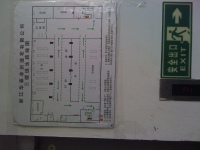Spent Monday at our main bag factory – the drive out took over an hour and a half through clusters of factories and fields. We’ve worked with this factory for over a year and have been impressed with their quality. It was so great to spend the day with Tony, the factory manager, after so much time spend on emails. We started an audit process a year ago to start gauging their social compliance to ensure they meet our standards, and those of a key client.
In our morning meeting we talked about the process to date -we’re the first customer that had requested this kind of audit from them. While they’d been through ISO9000 audits by firms like SGS they’d never been through a process focused on human rights, worker health and safety, and environmental standards. In partnership with our client, we having been working with the external auditing firm Openview from Hong Kong.
Tony reflected on how he sees their efforts to meet the Code requirements the Fair Labor Association and others as a key differentiator in a very competitive market. If you go to Alibaba– a global trade database, and search “Non Woven Bags” you get 78000 names of manufacturers in China alone – it’s hyper competitive.
He feels that working with Fairware on meeting the expectations of social compliance programs can help them attract the premier brands. Recently they’ve been approached by a UK brand to do some work and the client has indicated the factory will have to meet the Ethical Trading Initiative standards – UK’s version of the Fair Labor Association .
FACTORY OVERVIEW
The factory consists of 4 buildings – one where they manufacture the non-woven material, one where they warehouse the fabric for shipping to other finishers, one is canteen and offices for management, and one is for finishing – the sewing, finishing, cutting,and packaging. When I arrived, the factory was in the mi ddle of production for 1 million unit bag order – for a major multinational food product company for use in the domestic market in China.
We first visited the material workshop – where they take polypro pellets (clear) and turn them into coloured non woven polypro “fabric” to make products from (mostly bags). The pellets are vacuumed up to the top of the building where they enter a machine that melts them down & where the cclours are added by a computer driven system to ensure exact colour matches. The melted plastic is dried into sheet that is rolled between drums to give it the ‘texture of a bag’.
Any offcuts (from the sides and ends of rolls and off the cutting room floor) are sent back up to the top of the machine to be added to the pellets, melted down and recycled into the next batch of fabric. Most of the recycled content in these type of bags refer to this pre-consumer content – or scraps form the shop floor. Having a fabrication workshop on site means any scrap material from the sewing and finishing workshop is easily recycled.
One the fabric is made,it is cut – 250 layers at a time. Then, in the case of unlaminated bags it is printed with the logos. In the case of laminated bags the image is laminated to the base fabric in advance of being cut. Then elements are sewn – such as gussets, handles, front back panels – & assembled and packaged.
After the tour of the facility we spent the remainder of the day reviewing efforts to date to improve the factory conditions in terms of health and safety, worker rights, ect. Over the past year the factory has made significant improvements including changing to a new payroll tracking system to make calculating minimum hourly wages easier and changing worker contracts to decrease the length of probation times.
We toured the factory to assess fire safety systems to ensure exits were clear, well marked and had functioning emergency lighting. While many of the elements of the review are things we’d take for granted (are there emergency exit plan posted), they are not always in place in factories.
I was encouraged to see where changes had been made to improve worker safety.
Tags: China, Ethical Sourcing, fair labor, fairware, sustainable product, tote bags





March 22, 2010 at 5:44 am |
I am looking for a sewing company to attach a poly pouch to a product. Does your company out source in sewing. Teresa
March 26, 2010 at 10:46 am |
Teresa – Please contact us at info@fairware.ca. We don’t contract sew but might have some ideas for you.